Leafy side dish, staple of Lankan cuisine
View(s):In the second in our series on edible leafy greens, we feature ‘mallung’ a popular and nutritious side dish to the Sri Lankan rice and curry
By Dr. Nirmala M. Pieris
Mallung, is a nutritious Sri Lankan dish that can be made with one or a number of edible green leaves. When it is a mixture of leaves it is commonly known as a ‘kalavang mallung’. To make the mallung, cut up the leaves finely, mix with grated coconut, finely sliced red onions, green chilies, curry leaves and salt. Heat a pan, add the mixture and toss for a few minutes. Do not overcook as the green of the leaves which is due to the chlorophyll will turn brown thereby losing the attractiveness of the dish and also resulting in nutritional losses. Add a squeeze of lime and there you have a ‘mallung’ which is very much a part of Sri Lankan cuisine. Today we feature leaves that can be used in the preparation of mallung.
Japan batu
Sweet Leaf or Japan Batu, Sauropus androgynus in the family Euphorbiaceae is a small woody plant. The plant is sometimes referred to as the “multigreen” or “multivitamin” plant due to its high nutritive value and dietary protein. The leaves are oval in shape, have a pleasant nutty taste and have appreciable levels of pro-vitamin A carotenoids, vitamins B, C, K and minerals especially potassium. The dark-green leaves are a rich source of chlorophyll which is a valuable blood building element and cell rejuvenator. The leaves have also been featured in weight control diets.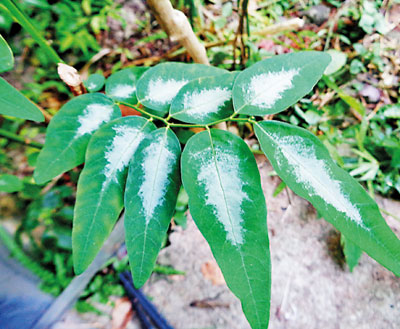
Beet greens
Beta vulgaris, beetroot is a tuberous taproot belonging to the family Amaranthaceae. Beet greens are the young, leafy-tops of the plant that carry more minerals, vitamins and health benefiting pigment antioxidants than its taproot. Beet greens are a good source of dietary fibre, vitamins A, B complex, C and K and also a rich source of minerals. These constituents in the beet greens offer protection from vitamin A deficiency, osteoporosis, iron-deficiency anemia, and are believed to guard against cardiovascular diseases and possibly colon and leukemia cancers.
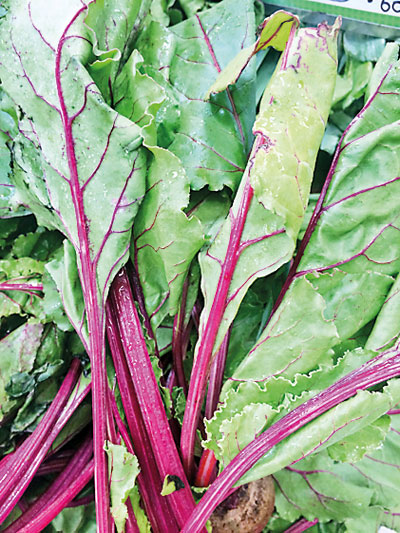
Cabbage
The outer dark green leaves of cabbage, Brassica oleracea variety capitata in the family, Brassicaceae is a storehouse of phyto chemicals. These compounds work as powerful antioxidants and are known to help protect against breast, colon, and prostate cancers. The leaves are incredibly nutritious and are also low in fat and calories. Fresh leaves are an excellent source of vitamins C, B complex and K. Moreover the leaves contain adequate amounts of minerals like potassium, manganese, iron, and magnesium. Potassium is an important component of cell and body fluids that helps controlling heart rate and blood pressure.

Kale
Kale or leaf cabbage, Brassica oleracea variety acephala belongs to the cabbage family Brassicaceae. The leaves of Kale the ‘headless cabbage’ are green or purple in colour, and have either a smooth or curly shape. Kale is called “the new beef”, “the queen of greens” and “a nutritional powerhouse.” Kale is high in fibre, calcium, iron, vitamins A, C and K. Kale’s cancer preventive benefits have been linked to its unusual concentration of antioxidants, namely, carotenoids and flavonoids. Kale is a pronounced anti-inflammatory food, great for cardiovascular support and helps lower cholesterol levels. Kale is filled with fibre and sulfur, both great for detoxifying your body and keeping your liver healthy.

Kathurumurunga
Sesbania grandiflora, kathurumurunga in the family Fabaceae is a fast growing tree. Leaves have 10 to 20 pairs of oblong leaflets and are rich in vitamin A and also contain vitamins in the B group and vitamin C. They are an excellent source of calcium and iron and thus their reputation as a bone strengthener.There is no better medication than kathurumurunga to cure cracked lips and tongue and mouth ulcers with the best preparation being leaves cooked in ghee or gingelly oil. It is also beneficial for skin, boosts immunity, lowers blood pressure and prevents migraine and weakness. The leaves are delicious crispy fried and can also be used in a stir fry, while tender leaves are used for a sambol.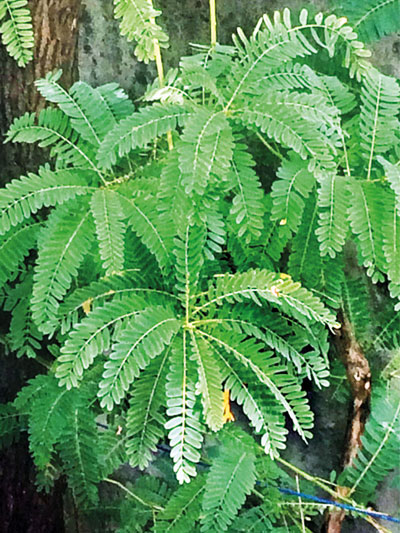
Knol Kohl leaves
Knol Kohl, Brassica oleracea variety gongylodes in the family Brassicaceae is a stout, round, tuberous vegetable. Knol Kohl leaves or tops, are abundant in vitamin A, B-complex group of vitamins, vitamin K and minerals. The leaves also have significantly high levels of calcium and reasonable levels of phosphorous and iron. The health benefits of the leaves include their ability to improve your digestive processes, boost the immune system, regulate metabolism, strengthen bones and improve vision health.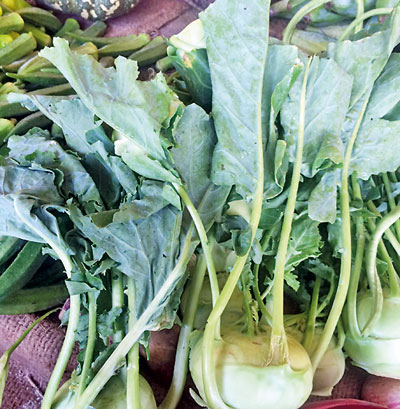
Koppa kola
Polyscias scutellaria, koppa kola in the family Araliaceae is a much-branched evergreen shrub or small tree. The leaflets are broadly elliptic and papery to almost leathery and edges are slightly serrated. The leaves are fibre rich and thus good for intestinal and urinary disorders and are reported to be used in treating hair loss. The leaves also contain high levels of iron and thus prevents anemia. It also contains vitamin A, which is good for eye health and vitamin C, that helps heal mouth sores, and gum problems. Leaves are mainly used for a mixed mallung.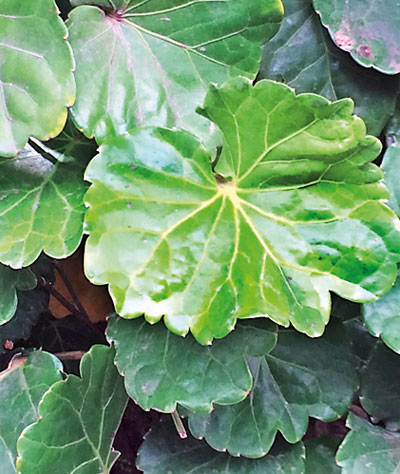
Madatiya
Madatiya, Adenanthera pavonina in the family Fabaceae is most famous and diagnostic for its shiny, hard red seeds. The leaves that are bipinnate with oval leaflets that are relatively large are fairly high in digestible crude protein but low in mineral content. The young leaves have been used to treat diarrhoea and are reported to have antibacterial activity and are also used against rheumatism and gout.Leaves are mainly used for a mixed mallung.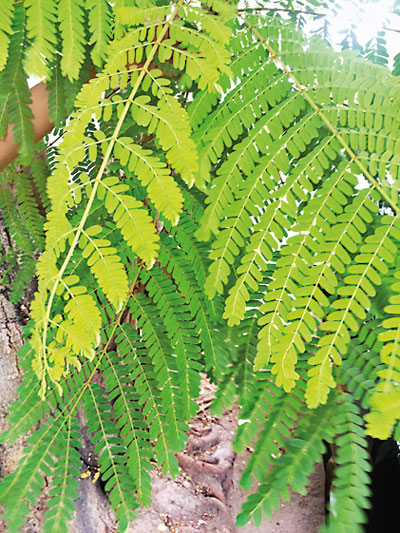
Manioc
Manioc, also called Cassava, Manihot esculenta in the family Euphorbiaceae is mainly grown for its root which is a rich source of carbohydrates. It is a woody plant with erect stems and spirally arranged simple lobed leaves. Manioc leaves and roots must always be consumed after cooking as they are high in hydrocyanic acid which is extremely poisonous. Most of the cyanide is liberated in the cooking process. Young tender leaves are a good source of dietary proteins, fibre, vitamins, A, B1, C and K and useful minerals potassium, phosphorous, calcium and iron. They are also a good source of antioxidants and due to the fibre content good for digestive health. Leaves are mainly used for a mixed mallung.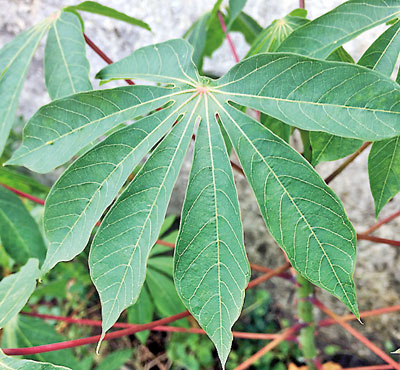
Mukunuwenna
Mukunuwenna, Alternanthera sessilis in the family Meliaceae is the most widely produced and consumed leafy vegetable in Sri Lanka. The leaves are an excellent coolant and also have anti-inflammatory activity. It is also a good home remedy for piles. The leaves are known to significantly reduce postprandial blood glucose levels. Mukunuwenna is moreover rich in iron, calcium and other vital nutrients and considered to have immense benefits for the eyes, hair and skin. Mukunuwenna also has high levels of dietary fibre and is thus used for simple stomach disorders and diarrhoea. The leaves can also be used in a curry and stir fry.

Rabu leaves
Radish, Raphanus sativu is an edible root vegetable of the Brassicaceae family. Similar to other root vegetables the leaves contain more nutrients than the radish itself with minerals such as iron, calcium, and phosphorous that are essential for many body functions. The leaves are also high in dietary fibre and contain vitamin C and K and as much as six times the vitamin C content of the roots.The high iron content makes it an ideal deterrent to fatigue while the fibre helps in reducing blood sugar levels. Radish greens contain glucosinolates with anti-cancer potential. 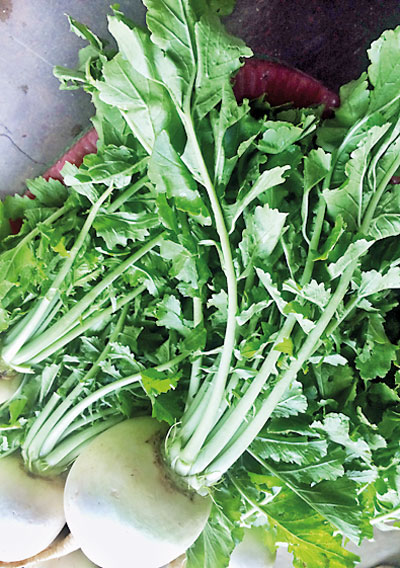
Murunga
Murunga, Moringa oleifera is the only genus in the family Moringaceae. Also known as drumstick, the leaf is best known as an excellent source of nutrition and natural energy booster that is not based on sugar, and so sustained. They contain three times more iron than spinach and thus are good for anemia. Moringa leaves contain about 30 antioxidants that contribute greatly towards healthy skin. Moringa leaves also contain sulphur which is the key ingredient for collagen and keratin. Leaves are mainly used for a mixed mallung and tender leaves used for a sambol.
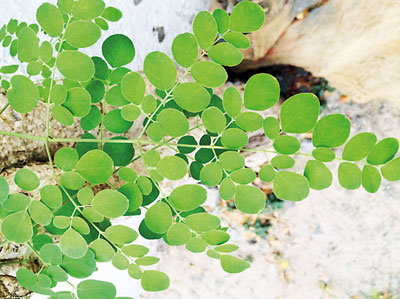
Thumbe
Leucas zeylanica, Geta thumba in Sinhalese in the family Lamiaceae is a small, terrestrial, herbaceous plant with long thin leaves that can be seen near paddy fields and grass lands. Geta thumba is very effective for the prevention of phlegm diseases and is also good for worm diseases and toxic conditions of the skin. It is also effective in purifying blood and getting rid of swellings and pain of the body and is believed to cure fevers, diseases of the liver, dysentery, coughs and asthma. The leaves are also made into a curry.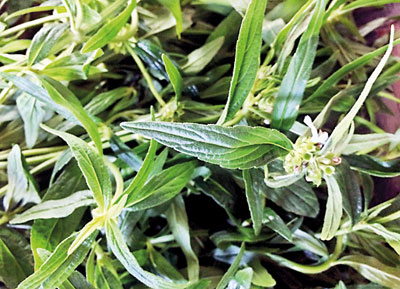
Letta kochchi
Pisonia alba, Letta kochchi also called Vatha banga in the family Nyctaginaceae is a tree that can reach a height of four to seven metres. The leaves that are of a pleasing pale green colour are long and pointed. Planted in good sunlight, the leaves may acquire a light yellow colour. The young leaves are especially good when cooked and eaten by those suffering from rheumatism or arthritis. The leaves also expel flatulence and are reported to have anti-diabetic activity.
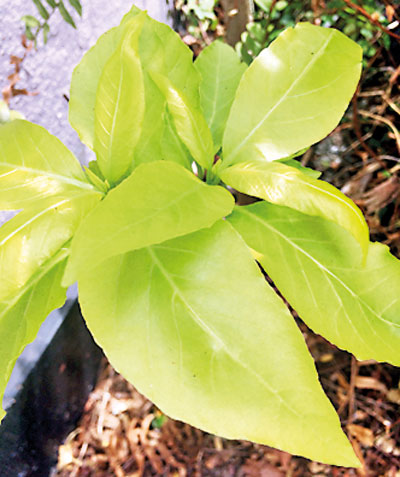
Some of the leaves used for preparation of sambols, as featured in MediScene of August 21 can also be used for mallung, at most times for mixed mallung. These are the more mature leaves of Ambarella, Anguna, Kurinnan, Passion fruit, Thebu and Wel penela.


